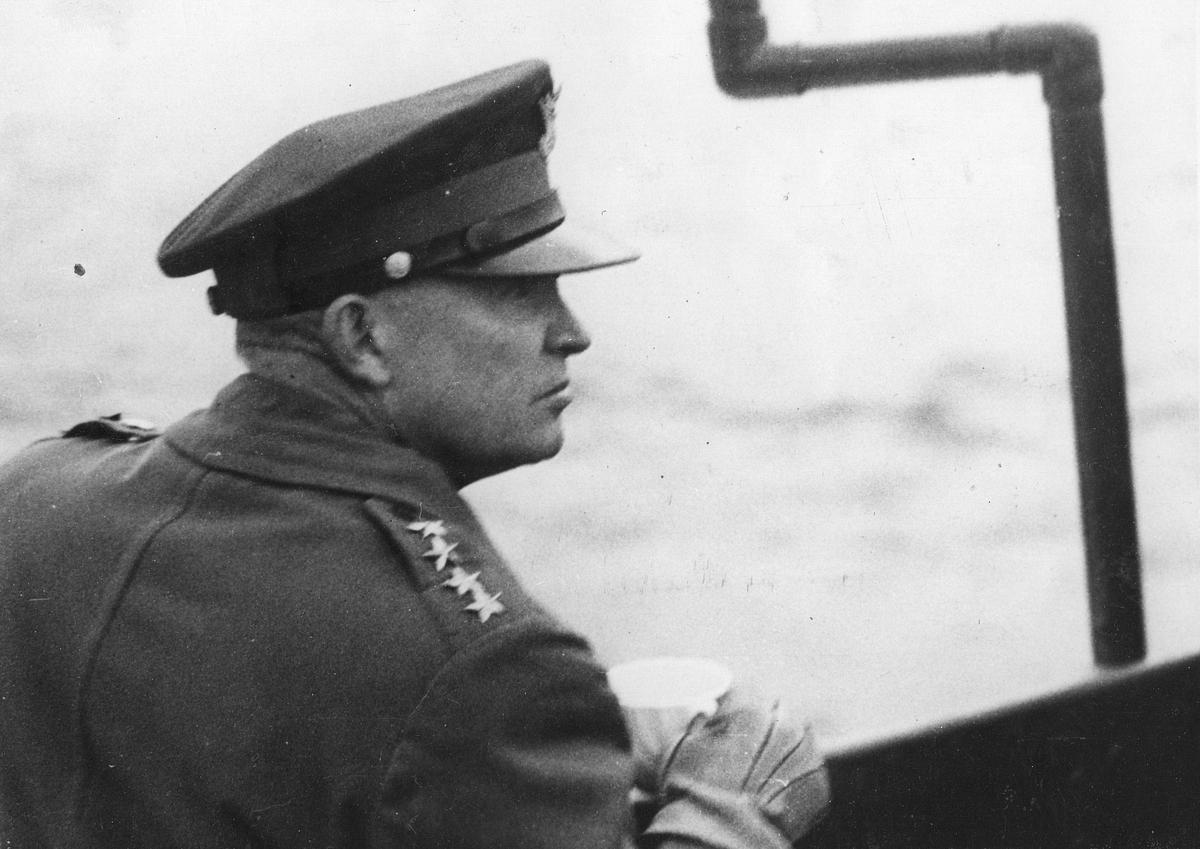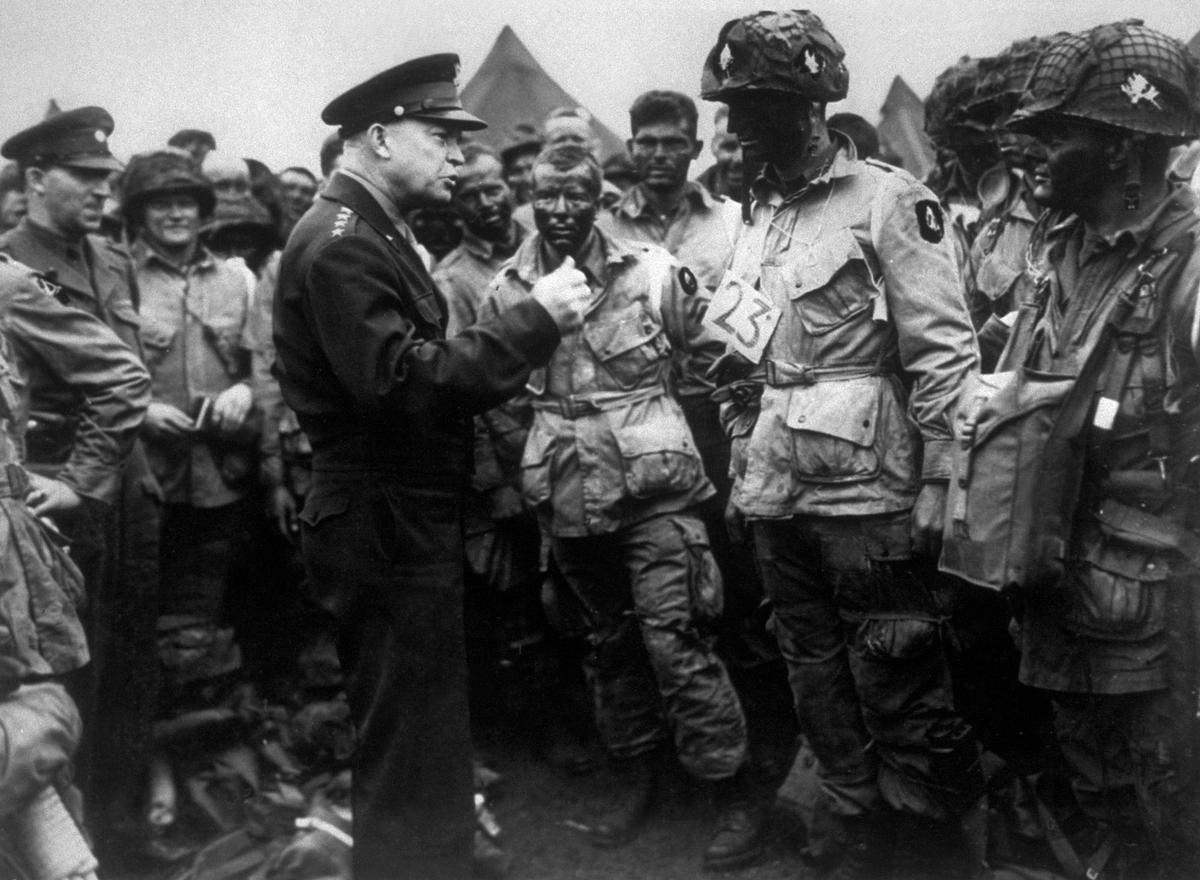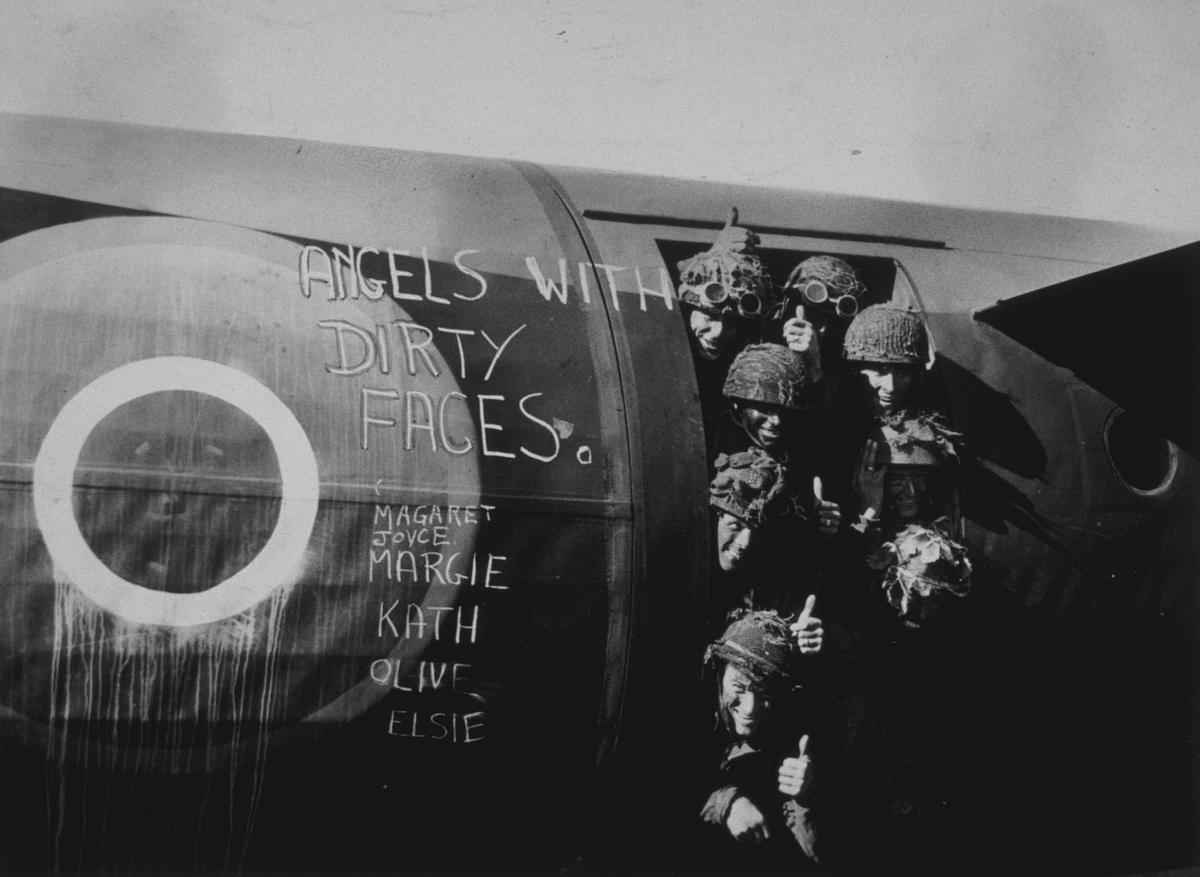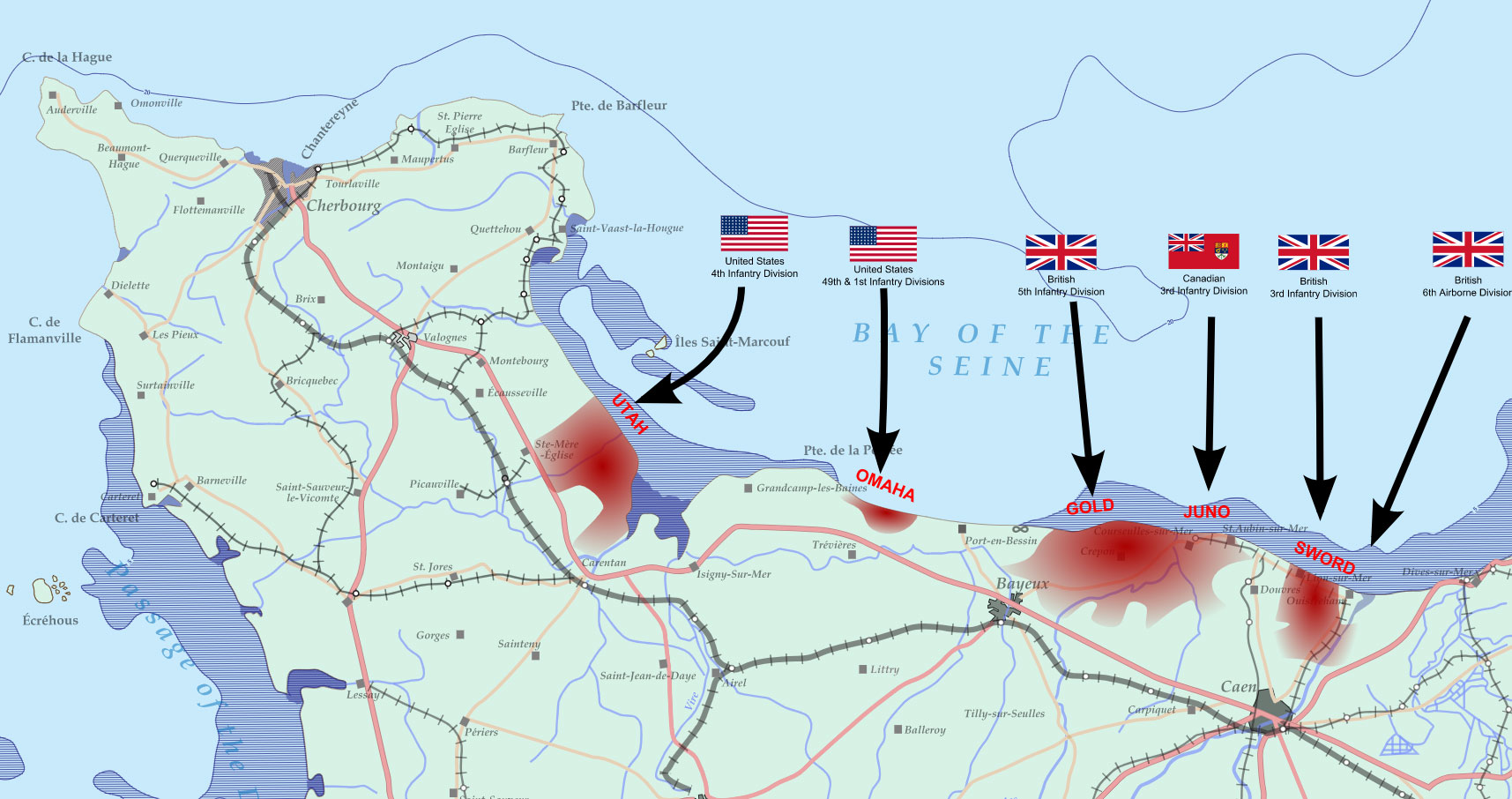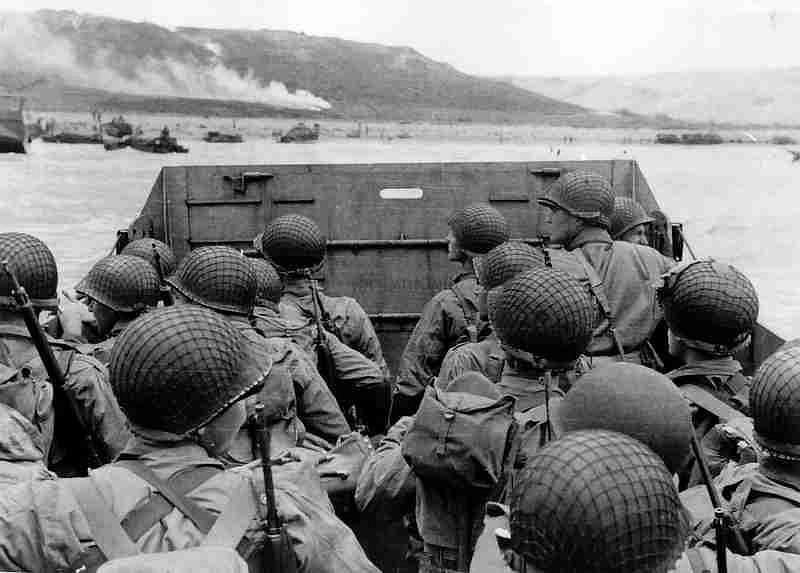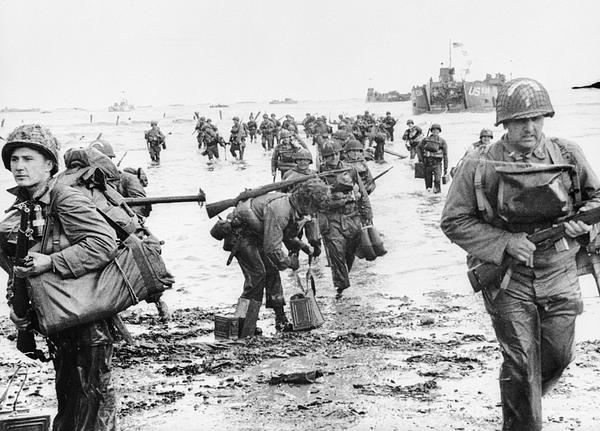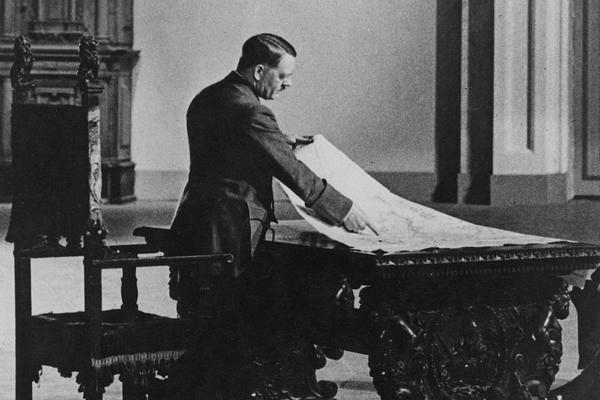
When allied forces invaded Nazi-occupied France it marked the beginning of the end for Adolf Hitler and the Nazi domination of Europe.
Less than a year later, World War Two was over and history was made.
This is what happened on that momentous day.
'Let's Go!'
5 June, 04.17: Eisenhower gives the go-ahead
US General Dwight D. Eisenhower, the Supreme Allied Commander in Europe, gives the final go-ahead for the invasion.
Speaking about his decision to invade, despite a storm which had been battering the English Channel and forcing a delay, he tells troops that “the eyes of the world are upon you.”
The Allied forces have been training for D-Day since mid-April 1944, with Exercise Tiger - a rehearsal of the invasion.
These large scale rehearsals took place in Slapton Sands in Devon and they didn’t go completely smoothly, with coordination and communication problems resulting in friendly fire deaths during the exercise.
D-Day's codename is Codenamed Operation Neptune and will be the largest seaborne invasion in history.
It comes off the back of Operation Fortitude - a complex campaign of deception involving setting up false army groups (based in Edinburgh and the south of England) in order to deceive the Germans into thinking that the real attack was going to be at Pas-de-Calais and Norway, not Normandy, which was thought to be a diversion.
The proposed plan for D-Day will see around 132,715 troops to land on five beaches with over 23,000 paratroopers to be dropped inland.
Almost 7,000 ships will also be involved and although the mood is confident, Eisenhower has prepared a speech in case the invasion fails.
Dwight D. Eisenhower's speech in full
Soldiers, sailors and airmen of the Allied Expeditionary Force.
You are about to embark upon the Great Crusade toward which we have striven these many months. The eyes of the world are upon you. The hopes and prayers of liberty-loving people everywhere march with you. In company with our brave allies and brothers-in-arms on other Fronts, you will bring about the destruction of the German war machine, the elimination of Nazi tyranny over the oppressed peoples of Europe, and security for ourselves in a free world.
Your task will not be an easy one. Your enemy is well trained, well-equipped and battlehardened. He will fight savagely.
But this is the year 1944! Much has happened since the Nazi triumphs of 1940-41. The United Nations have inflicted upon the Germans great defeats, in open battle, man-to-man. Our air offensive has seriously reduced their strength in the air and their capacity to wage war on the ground. Our Home Fronts have given us an overwhelming superiority in weapons and munitions of war, and placed at our disposal great reserves of trained fighting men. The tide has turned! The free men of the world are marching to victory!
I have full confidence in your courage, devotion to duty and skill in battle. We will accept nothing less than full victory!
Good luck! And let us all beseech the blessing of Almighty God upon this great and noble undertaking.
5 June: The night before
17.00: Boats assemble at 'Piccadilly Circus'
Boats and ships making up the biggest fleet the world has ever seen gather in what will become known as ‘Picadilly Circus’ - a spot just south of the Isle of Wight.
After a delay due to the storm, troops on board are ready to go and travel with supplies and ammunition to the French coast.
6939 vessels – 1,213 warships, 4,126 landing craft, 736 ancillary craft and 864 merchant vessels – gather in preparation for landings at five Normandy beaches codenamed Utah, Omaha, Gold, Juno and Sword.
22.00: Airborne troops check equipment
The troops who are to be dropped inland check their equipment, which includes two chutes, life jackets and various weapons.
Their kit is so heavy they have to be escorted onto planes and gliders.
Eisenhower visits the American 101st Airborne division and says “the trick is to keep moving.”
00.00: Operation Titanic
Part of Operation Fortitude, Operation Titanic sees the RAF drop hundreds of dummy paratroopers across Calvados, Manche and Seine-Maritime in order to distract German anti-paratrooper units from where the actual landings will take place.
Speaking about the advancement before the airborne assault, and the success of the diversionary tactics, Major John Howard later said:
“We were coming in at 90 mph on touchdown. I suppose that really was the most exhilarating moment of my life. I could see the bridge tower 50 yards from where I was standing. Above all, the tremendous thing there was that there was no firing at all. We had complete surprise, we had caught old Jerry with his pants down.”
6 June, 00.06
Although there is bright moonlight, the first glider pilots still rely on instruments to ensure they end up in the right place.
Some gliders crash land and the troops run to their target bridges where some of the foreign conscripted soldiers guarding them leave their posts, meaning there’s only Germans to return fire.
After only 10 minutes the Allies hold the bridges and send out the success signal: ‘ham and jam’.
01.55: Sainte Mere-Eglise liberated by paratroopers
This strategically important town on the main road to Cherbourg is one of the key places targeted.
On the morning of the 6th, American paratroopers drop in and around the town. About 1,000 troops gather with the aim of liberating the town from the Nazi occupiers and after a few hours of fighting there is success for the Allied troops.
Some paratroopers never see the liberation as they have been dropped too far or in the wrong place and drown in the deliberately flooded countryside.
The landings
As the sun rises, the Allied naval forces start their bombardments of the beaches with seven battleships, 23 cruisers and 103 destroyers.
05.23: Allied warships open fire on German defences
These bombardments aim to hit the large German batteries, which threaten the invasion forces.
British RAF bombers have been firing at the defences for about 5 hours. American USAAF join the bombardment around 6am.
06.00: Eisenhower addresses Normandy
The BBC broadcasts a message from General Eisenhower to the people of Normandy:
"The lives of many of you depend on the speed with which you obey. Leave your towns at once – stay off the roads – go on foot and take nothing with you that is difficult to carry. Do not gather in groups which may be mistaken for enemy troops."
06.15 H-Hour nears
6.30am is H-Hour, the time of day at which an attack, landing, or other military operation is scheduled to begin.
In preparation, rocket launcher barges approach the targeted beaches and fire them with rockets: around 20,000 in Gold, Juno and Sword beaches and 18,000 in Utah and Omaha.
06.30: US troops land on the Normandy beaches
The 1st and 29th American Divisions land over a four-mile front at Omaha, and the US 4th Division assaults Utah in preparation for 23,250 to land there.
Troops assigned to Omaha and Utah beaches start to get into landing craft and set sail for the beaches despite the choppy conditions, which makes many sick.
Brigadier General Theodore Roosevelt Jr, the 56-year-old son of the former president and assistant commander of the 4th Division, is in the first wave assault.
06.48: Berlin announcement
Germans hear from Berlin Radio that Allied troops are landing in France.
07.30: British and Canadian assaults on Gold, Juno and Sword beaches
After the American assault, British and Canadian forces fire on their beaches - Gold, Juno and Sword.
H-Hour for these beaches is being led by the British 50th Division, under the command of Major General Douglas Graham (Gold beach).
The British 3rd Division, led by Maj Gen Tom Rennie, lands at Sword beach and on Juno beach, the 3rd Canadian Infantry commanded by Major General Rodney Kellner lands.
The plan for Gold beach is to clear the way for an artificial harbour and then head to Bayeux via Caen. Progress is good, with around 413 casualties out of around 24,900 landing troops.
At this time, Field Marshal Erwin Rommel - the man in charge of German defences in northern Europe, is informed of the invasion from his chief of staff. Hitler is still asleep.
08.00 Allied announcements
Frederick Allen reads the BBC news:
"Supreme Allied Headquarters have issued an urgent warning to inhabitants of the enemy-occupied countries living near the coast. The warning said that a new phase of the Allied air offensive had begun."
General Eisenhower sends his initial report back to headquarters:
"All preliminary reports are satisfactory. Airborne formations apparently landed in good order... Preliminary bombings by air went off as scheduled."
08.20: On Omaha, American soldiers face waves of machine gun fire
In what will become known as ‘'Bloody Omaha', the American troops face heavy attacks from German forces which are stronger than first thought.
In the lead up to the attack, many landing crafts miss their targets or are swamped by rough seas. There is also mine damage to ships at this time. Troops who have survived huddle together and wait for the tanks which have made it ashore and are shooting at Germans as well as providing cover.
Allied troops on other beaches such as Utah are not in such a perilous a position although mines in the water are causing damage.
09.00 Hitler awakens
Hitler is finally awake at the Berghof, Berchtesgaden.
He finds the news from Normandy excellent, as he still thinks - thanks to Operation Fortitude's chain of deceptions - that the morning's events are a cover for the real invasion at Pas-de-Calais.
09.32: Communiqué No. 1
In London, the BBC broadcasts a special news bulletin - Communique No 1 - on its Home, Overseas and European Services - the first official announcement of D Day.
Newsreader John Snagge tells listeners that Allied forces have landed in France under the command of General Eisenhower.
German radio has already been broadcasting news of the invasion for two hours, after the initial announcement on Berlin Radio.
"This is London. London calling in the Home, Overseas and European services of the BBC and through United Nations Mediterranean, and this is John Snagge speaking.
"Supreme Headquarters Allied Expeditionary Force have just issued Communiqué No 1.
"Communiqué No 1: Under the command of General Eisenhower, Allied naval forces, supported by strong air forces, began landing Allied armies this morning on the northern coast of France.
"I’ll repeat that communiqué.
"Communiqué No 1: Under the command of General Eisenhower, Allied naval forces, supported by strong air forces, began landing Allied armies this morning on the northern coast of France.”
'Things look better'
11.30: Omaha situation improves
Allied ships have come in close and are destroying the German positions at point blank range. This has cleared the way for troops to reach the cliffs where they can see the casualties on the beach.
Despite considering abandoning the assault on Omaha beach, General Bradley gets a message to say that ‘things look better’.
Allied troops are coming in en masse on the shore and inland but face strong resistance from German positions.
12.00: Churchill updates the House of Commons
The Prime Minister is in Westminster addressing a packed House of Commons.
After a lengthy update on the war in Italy, he says:
"I have also to announce to the House that during the night and the early hours of this morning the first of the series of landings in force upon the European Continent has taken place."
He adds that so far all is going according to plan.
12.00: Hitler holds his daily military conference
At his headquarters in the Bavarian Alps, Adolf Hitler thinks it's looking good for the Germans.
Because of the success of Operation Fortitude, Hitler still thinks the attacks and landings are a diversionary tactic and that the real invasion will be at Calais.
He is cheerful and is convinced that the Allies will be driven back into the sea.
14.00: Crowded beaches and heroism
Now the initial landings are over, the beaches are buzzing with activity as more and more soldiers are coming ashore, the wounded are being treatment and wreckage is being cleared away.
German mines are also being cleared to make a safe path.
Company Sergeant Major Stanley Hollis of the Green Howards clears trenches, takes out pillboxes and leads a successful enemy attack which sees him save two men left behind.
He will be the only winner of a Victoria Cross on D-Day.
14.30 Disaster at Caen
Capturing Caen is a key objective, but it isn’t going well.
Allied airforces are firing at German forces but the enemy tanks and infantry are moving and causing a threat to the Allied beach-head.
On top of this, few civilians have left the town despite Allied leaflets warning them of the aerial attacks. Hundreds have been wounded or killed in the bombardment and parts of the city are on fire.
Despite the attacks, Caen is still in the hands of the Nazis.
15.00: Mulberry Harbours
The first sections of two artificial harbours code-named Mulberry are now heading across the Channel.
These huge concrete and steel constructions have been devised to help the allied troops resupply invasion forces and are particularly helpful in bad weather conditions.
18.00: German fightback
A German armoured ‘Panzer’ division has been attacking British forces between the Juno and Sword landing zones.
This slows the advance as a few Germans battle their way to the coast but by the evening, most of their tanks are destroyed.
The BBC broadcasts a speech from General Charles De Gaulle in which he calls on Frenchmen to "fight with all the means at their disposal".
General De Gaulle gives thanks to the British for their effort in the liberation of France.
On hearing this, it’s reported that Churchill wells up and shouts to an uncomfortable looking chief-of-staff: “You great tub of lard! Have you no sentiment?”
'The longest day'
20.00: British patrols approach Bayeux
British patrols are approaching Bayeux, another major first day objective.
But they won’t get there until tomorrow due to being behind by about three miles.
It will be the British 50th Division from Gold beach that liberates the town, as they have now joined forces with Canadian allies who landed at Juno beach.
At this time, Arromanches is captured, a key point for the Mulberry harbours.
21.00: 'More than courage'
As night approaches, fighting continues and more troops are arriving by glider to join the battle
Some 14,000 allied troops have landed along the 55 mile front and some have advanced miles inland.
But all is not over as German troops have moved north and some are still defending the beaches.
King George VI broadcasts to his people and asks them to pray: "At this moment not one of us is too busy to play a role in a worldwide vigil of prayer."
23.59: Allies take stock of D-Day
By midnight, the Allies can take stock of what has been an extraordinarily successful day
Despite still not taking Caen and suffering thousands of casualties, they managed to gain a foothold in France.
Caen will continue to be bombed with the 185th Brigade close by. The destroyer, HMS Faulknor, leaves Portsmouth and Operation Mallard begins, with 250 gliders, escorted by RAF fighters, bringing reinforcements and equipment.
159,000 allied troops have, on this day, established four beachheads. Fighting will continue but a crucial stage has been reached.
This day will mark the start of the liberation of Western Europe.
Within the year the Allies will have won and Hitler will be dead.
